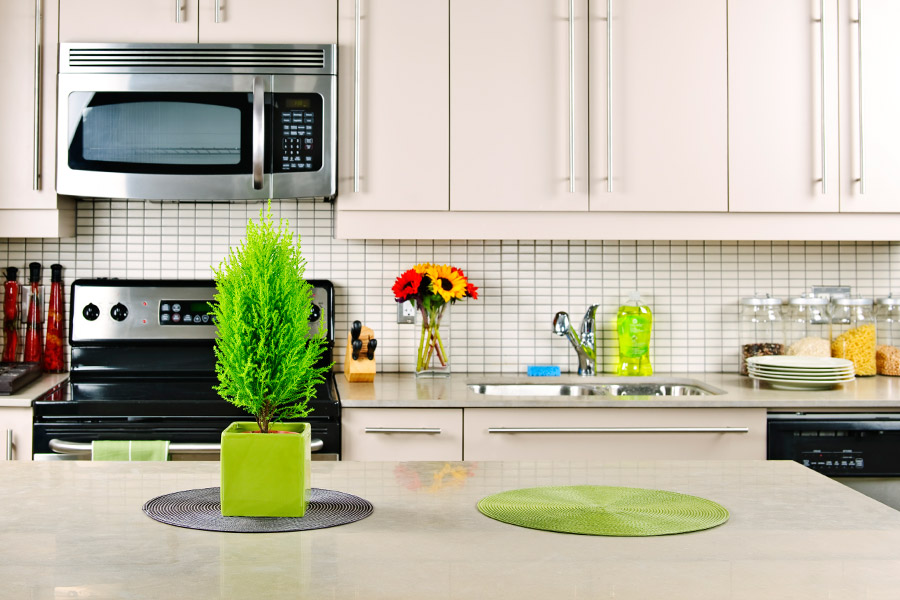
We live in a bountiful time with many materials to choose from for our household countertops, in this case soapstone vs granite countertops.
Who would have thought that picking one could be a problem? While granite has been a mainstay considered the “go to” material for kitchen counters, soapstone is making a comeback as a viable alternative. It can be difficult to choose between the two; although they are very different in color and texture, both yield the warmth and beauty of natural stone.
Granite Is a Dynamic Choice for Any Room
Granite has a rich beauty that few other counter materials can match. It is a natural product with timeless appeal and is highly resistant to scratching. Problems can occur, however, if you don’t seal it properly. Unsealed or poorly sealed counters can absorb wine, juice and oils, producing a stain that might be impossible to remove.
Granite, an igneous stone composed of quartz and feldspar, is one of the hardest materials on Earth, which is one reason it is so popular for kitchen counters. Then there is its beauty. Its designs can be very tight, made up of small, dense mottling or large swirls of multicolored red, pink, gray and white in varied combinations. When you purchase granite, you can pick the specific stone so you know exactly what you are getting. Granite makes a bold, dramatic statement in your home, no matter how you use it. It can make choosing a backsplash problematic as you don’t want to compete with the bold impact of the granite design.
Soapstone’s Monochromatic Quality Makes It Easy to Accent
Soapstone tiles and panels are excellent choices where heat and moisture are likely. Soapstone is dense, has no pores, does not stain and repels water. Those properties make soapstone tiles and wall panels a good choice for showers, tub surrounds and backsplashes.
Soapstone is a metamorphic rock composed of talc and other minerals. It got its name because it feels like soap. Soapstone does not have the dramatic variation of granite. It is usually gray, bluish, green or brown and may have variegated veins. After you set it in place, you should rub it with mineral oil to accent the stone’s striking marbling. Soapstone is more resistant to stains and chemicals than granite is. It is unaffected by acids and alkalis; tomato juice, wine and vinegar do not discolor the stone. Also, you can put a hot pot on soapstone and it won’t damage the surface. Unfortunately, soapstone is a soft rock and easily scratched. Sanding and treating it with mineral oil will replace its sheen, but a professional must perform the process. In terms of design, soapstone’s soft, muted colors invite bright, bold accents to compliment its supple quality.
Which Should You Choose for Your Counter?
Granite’s scratch resistance makes it a good option for kitchens, and the color choices are virtually unlimited. However, granite is porous and can stain. Soapstone is nonporous and resistant to bacteria. Soapstone is widely used for masonry, heaters and countertops in forensic and science labs as it is highly resistant to chemicals so you don’t have to seal it. How and where you plan on installing your countertop are deciding factors for which stone you choose.
Natural Stone Requires Extra Care
There is nothing like the beauty of natural stone in our homes. Its warmth cannot be duplicated by manufactured or machined products. Whether you pick granite or soapstone, however, natural stone counters require extra maintenance. Being softer than synthetic products, some natural stones, such as granite, must be sealed with a water- or oil-based liquid after installation and then once or twice a year to maintain their sheen and resist staining. You can purchase good commercial granite and marble sealants from home supply stores or tile and stone retailers. Before sealing the stone, wipe it with a clean, damp cloth and let it dry, so you don’t seal in dust or food particles. Apply the sealant with a sponge or paint roller, using enough to leave a thin layer across the stone. Let it sit for about 5 minutes, then wipe with another clean, dry cloth. Allow the countertop to dry for 24 hours before using it. Soapstone is more forgiving, but if it needs sanding you must hire a professional.
Source: Hunker
View Original Post


